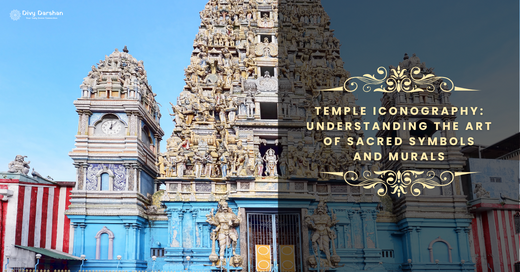Temple Iconography: The Art and Meaning of Sacred Symbols and Murals
Religious temples across the world hold more than just spiritual significance; they are a window into history, culture, and artistic tradition. One fascinating aspect of temples is their iconography – the sacred symbols, murals, and images that adorn their walls. Temple iconography, or Divine Illustrations, not only beautifies these holy places but also tells ancient stories, conveys deep meanings, and offers insights into beliefs and values. Let’s dive into this intriguing world and understand why these illustrations are so revered.
What is Temple Iconography?
Temple iconography refers to the art and symbols found in temples. These symbols are not merely decorative; they represent divine concepts, stories of gods and goddesses, cosmic beliefs, and moral teachings. These illustrations, found on walls, ceilings, and pillars, have been created by skilled artisans and are meant to evoke feelings of devotion, peace, and spiritual curiosity among visitors.
For example, Hindu temples might show vibrant murals depicting stories from the Ramayana and Mahabharata, while Buddhist temples often feature depictions of the Buddha’s life. Each image, whether of gods, nature, or cosmic symbols, is carefully chosen to resonate with the temple’s purpose.
Why is Temple Iconography Important?
Divine illustrations in temples have a two-fold purpose: education and inspiration. They help people understand complex ideas, such as the nature of good and evil, the importance of devotion, and the mysteries of the universe, through images and symbols. This was especially valuable in ancient times when written texts were less accessible to the general public. Through temple murals and carvings, even those who couldn’t read could grasp these spiritual ideas.
Additionally, these illustrations serve as a form of worship. The very act of creating divine illustrations is considered a sacred activity, as artists devote their skills to crafting images that inspire faith and connection to the divine.
Common Symbols in Temple Iconography
Many divine illustrations have become widely recognized due to their presence in temple art. Here are a few common symbols and their meanings:
-
The Lotus
The lotus is a powerful symbol in Hinduism, Buddhism, and other Eastern religions. Representing purity, enlightenment, and rebirth, the lotus often appears beneath the gods, symbolizing their divine nature rising above worldly impurities. -
Mandala
Often seen in Buddhist and Hindu temples, mandalas are geometric designs symbolizing the universe. They represent the idea of unity and interconnectedness and are often used in meditation practices. -
Nandi the Bull
In Hindu temples dedicated to Lord Shiva, Nandi, the bull, is a common figure. Nandi is considered the gatekeeper of Shiva and symbolizes loyalty and strength. -
Bodhi Tree
The Bodhi tree, under which the Buddha attained enlightenment, is a sacred symbol in Buddhist iconography. Many temples feature illustrations or carvings of this tree as a reminder of spiritual awakening.
Murals as Storytellers
One of the most captivating aspects of temple iconography is the way murals are used to narrate ancient tales. Stories of divine beings, heroes, and moral lessons are illustrated in vibrant colors and intricate detail on temple walls. These murals act as a visual scripture, guiding devotees on their spiritual journeys.
In Hindu temples, murals often tell stories from the Ramayana or Mahabharata, while Buddhist murals may depict the Jataka tales, which are stories of the Buddha’s previous lives. These paintings have lasting significance, inviting worshippers to connect with the stories of the divine.
Iconography as a Form of Meditation
Temple iconography does more than decorate; it also serves as a tool for meditation. By focusing on the symbols and murals, devotees can quiet their minds and reflect on the spiritual truths that each illustration represents. In this way, divine illustrations encourage visitors to not only admire the artwork but to also engage with it, using it as a path to inner peace and enlightenment.
Modern Interest in Temple Iconography
Today, there is a renewed interest in temple iconography as people seek to understand the spiritual heritage of their cultures. Many travelers and researchers visit temples worldwide to study these divine illustrations, appreciating the beauty, history, and symbolism they hold. Additionally, with the rise of digital platforms, people can now explore temple iconography from anywhere, gaining insights into the sacred symbols and stories that form a crucial part of religious traditions.
Conclusion
Temple iconography, with its rich array of sacred symbols, murals, and intricate designs, offers a unique blend of art and spirituality. These Divine Illustrations invite us to connect with the ancient wisdom embedded within temple walls. Through these symbols and murals, we find not only beauty but also stories, life lessons, and a means to explore spiritual beliefs. Next time you visit a temple, take a moment to observe the details in the iconography; each symbol has a story, each mural has a lesson, and each divine illustration invites you on a journey into the sacred.

